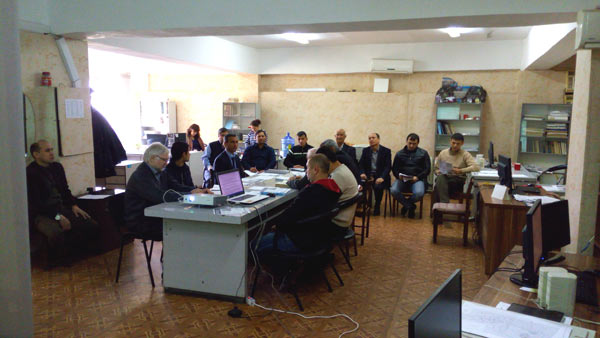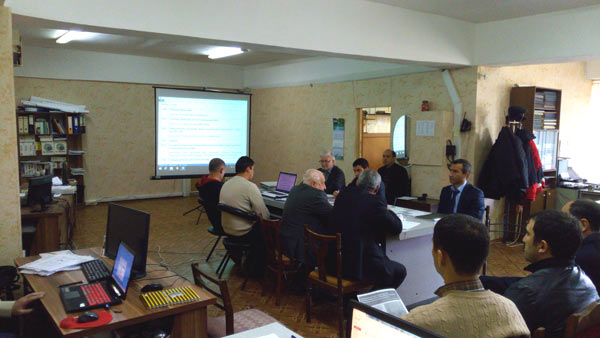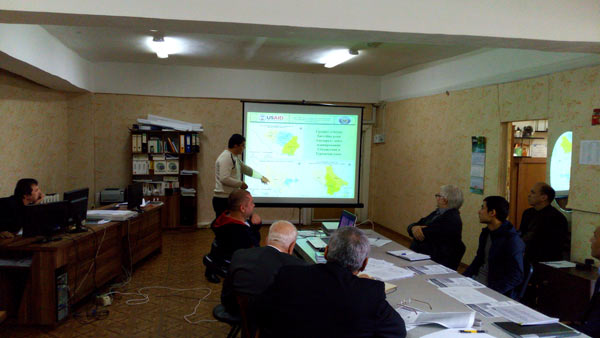WORKSHOP UNDER THE PROJECT “TRANSBOUNDARY WATER MANAGEMENT ADAPTATION IN THE AMUDARYA BASIN TO CLIMATE CHANGE UNCERTAINTIES”
26 October 2016, Tashkent, Uzbekistan
The workshop was held as part of the Project “Transboundary water management adaptation in the Amudarya basin to climate change uncertainties” at SIC ICWC premises in Tashkent on the 26th of October 2016. The participants included the representatives of SIC ICWC, Head of BWO Amudarya Mr. M.Makhramov, Head of Lower Shavat branch of Upradik Mr. D.Pirmatov, and the expert on Amudarya basin water management Mr. A.Nazariy.
The workshop program:
- Main tasks and results of the first project year – Prof. Dukhovniy V.A and Sorokin A. (SIC ICWC)
- Information provision in the Project: national and regional data, DB, GIS, web-site – Sorokin.D, Toshpulatov R., Zaitov.Sh, and Beglov.I. (SIC ICWC)
- Specifics of water management along the Amudarya River by territorial national divisions- M. Makhramov (Head of BWO Amudarya), D. Pirmatov (Head of Lower Shavat branch of Upradik, Turkmenistan), and Ŕ. Nazariy (SIC ICWC)
- Scenarios of agricultural development in the riparian countries of the Amudarya basin for 2020-2050 – Sh.Muminov (SIC ICWC)
- Climatic scenarios and climate change effects on water resources in the Amudarya basin – N.Agaltseva (UzHydromet)
- Constructing river runoff series for Amudarya basin for 2016-2050, scenarios of runoff regulation by hydropower reservoirs – A.Sorokin (SIC ICWC)
- Modeling crop water requirements in Amudarya Basin: methodology and results - G. Solodkiy (SIC ICWC)
- Effects of climate change on crop development phases – G.Stulina (SIC ICWC)
- PZ model: methodology and testing – R.Khafazov (SIC ICWC)
- Degree of adaptability of the water allocation system in Amudarya basin to regularly changing context: review of the legal and institutional framework – D.Ziganshina (SIC ICWC)
- Outcomes of the visit to the University in Baltimore, USA – R. Khafazov (SIC ICWC)
- Project objectives and tasks for 2017 (research stages 3 and 4) – V.A.Dukhovniy,

Director of SIC ICWC, Prof. V.Dukhovniy welcomed the participants. He underlined that the meeting is virtually the first one dedicated to the Amudarya basin. SIC ICWC has been trying repeatedly to attract attention to the needs of the basin by reporting at various conferences and disseminating information among international organizations and national agencies that the situation may be much worse in the Amudarya basin in the future than in the Syrdarya basin. The expected complexities and potentially growing water stress can be caused on the one hand, by climatic characteristics and glacial feeding of the Pyandj River and, on the other hand, be related to prospective increase in water use by Afghanistan and demographic growth. The international community allocates more and more funds (more than $3 billion in the last year only) to Afghanistan, with greater portion of money invested in irrigation development, especially along the Kunduz River. With the development of irrigation in the area of the Kunduz River, additional 4-6 billion m3 could be withdrawn from the tributaries of Amudarya and this would have a substantial effect on the Amudarya runoff. In dry period, the Amudarya River could lose about 7-9 billion m3. In this context, the main objective is searching reserves for water use. The Project allows us to discover these reserves. First of all, those imply automation, which helps to estimate river channel balance, substantially decrease losses, and, thus, partially cover water deficit. Based on our past research and this project, we could find a possibility to reduce water requirements through shortened growing season of plants because of rise in air temperature. Now it is necessary to study and work thoroughly on annual climate forecasts, the accuracy of which is of high relevance.

Then, the following presentations were made:
A. Sorokin “Main tasks and results of the first project year”. The first year included two work stages:
- Preparatory period – planning and design, during which the logical model for water management in the Amudarya basin was developed, the work methodology was prepared, and necessary data on climate, water, land, HEPS operation, agricultural product prices, etc. were collected and analyzed.
- Research. At this stage the following work was done: modeling of planning zones, water requirements (2020-2050), and river runoff series (2020-2050) in light of climate change; analysis of country development programs for 2020-2050 (socio-economic, agricultural and hydropower sector development); study of basin’s water demand for 2020-2050, legal and institutional aspects of transboundary water management; justification of alternative scenarios of HEPS operation for 2020-2050.
D.Sorokin, R.Toshpulatov, Sh.Zaitov, I.Beglov “Information provision in the Project: national and regional data, DB, GIS, web-site”. The reporters briefly presented the work on collection and analysis of data, the sources of data, and the project database; the data is aggregated by categories and indicators, with breakdown into planning zones and Amudarya river reaches (can be accessed via cawater-info.net/peer/). Further, the results of GIS-based mapping were presented, including the upper reaches of Amudarya basin (Tajik and Uzbek planning zones), middle and lower reaches (Uzbek and Turkmen planning zones). Finally, the project web-site was presented (cawater-info.net/projects/peer-amudarya/).

M.Makhramov, D.Pirmatov, A.Nazariy “Specifics of water management along the Amudarya River by territorial national divisions”. Four divisions for operation of intake structures, waterworks facilities, and interstate canals were established at BWO Amudarya with the head offices in Kurgan-Tube (Tajikistan), Turkmenabad (Turkmenistan), Urgench (Uzbekistan), and Takhiatash (Karakalpakstan). Performance of the transboundary water management system of Amudarya basin is monitored at gauging stations. Four territorial divisions of BWO Amudarya are the major providers of national data on Tajikistan, Turkmenistan, and Uzbekistan for the Project.
A.Sorokin “Constructing river runoff series for Amudarya basin for 2016-2050, scenarios of runoff regulation by hydropower reservoirs”. In his presentation Mr. Sorokin described the results of the work on reconstruction of river runoff for a period of time from 2000 to 2015, in particular for the Pyandj River. The analysis results and the downward runoff trends over 2010-2015 were demonstrated, as well as the modeled runoff series for 2016–2055 were presented. Trends of runoff regulation by the Vakhsh HEPS reservoirs were demonstrated and possible scenarios of runoff regulation by Nurek HEPS were shown for 2020 and 2050. Scenarios of energy demand in Tajikistan (and in Amudarya basin in general) and possibilities to meet this demand by hydropower and thermal power were also presented. For these assessments, the studies by the World Bank and the national energy development programs of Tajikistan, including measures for rehabilitation of existing HEPS, and other materials were used.
Sh. Muminov in his presentation “Scenarios of agricultural development in the riparian countries of the Amudarya basin for 2020-2050” familiarized the participants with forecast estimations, including the main criteria used in the three scenarios (BAU – business as usual, FSD – food security and development, and ESA – export-oriented sustainable adaptation of agriculture in the basin) and the research results.
G.V.Stulina “Effects of climate change on crop development phases”. The analysis of changes in bioclimatic potential (conducted for all planning zones in annual dimension) shows that the general rise in temperature potential needed for crop development shortens the crop growing season. The data were inputted into the database for calculation of crop water requirements.
G.F. Solodkiy in his presentation on “Modeling crop water requirements in Amudarya Basin: methodology and results" demonstrated the required list of input data, methodology and technique of calculation, and the achieved results.
D.R.Ziganshina, V.A.Dukhovniy “Degree of adaptability of the water allocation system in Amudarya basin to regularly changing context: review of the legal and institutional framework” (presented by V.Dukhovniy). The assessment of the degree of adaptability of the legal and institutional framework underlying the water management was guided by 4 criteria: availability of treaties and institutions empowered to deal with water allocation; flexibility of water allocation principles; availability of provisions and procedures concerning modifications and revisions of the water allocation system at present and in the long-term; provisions related to emergency actions. Major contraints for higher adaptability of water allocation in the Amudarya River basin were demonstrated and the ways to overcome the existing situation, e.g. improve communication among the territorial branchs of BWO and local coucils were suggested.
R. Khafazov in his presentation on “PZ model: methodology and testing” briefly told about the adaptation of the planning zone model (PZm), which is a part of the set of models ASBmm - Aral Sea Basin Management Model. This work entailed a number of tasks for planning zones: analyze the current status of the ASBmm system; analyze modules and architecture; apply IDEF family methodology for modeling of the PZm subsystem; apply IDEF0 and IDEF1X methodologies for design of the function and information parts of the model. The new structure of PZm includes: block for calculation of planing zone’s water balance; block for calculation of agricultural production and its losses in case of water shortage; block for socio-economic assessment. The resulted model was tested for conditions of the planning zones located in the Amudarya lower reaches (Turkmenistan, Uzbekistan).
R.Khafazov also told about his visit to the Morton K.Blaustein Department of Earth and Planetary Sciences, Johns Hopkins University in Baltimore, USA. In particular, he presented to the Project partners in the US the main results of SIC’s work in the first Project year, learned about methodologies and modeling methods, and got recommendations from the partners on how to apply the newly gained knowledge in the project and for further enhancement of scientific cooperation between SIC ICWC and the University.
V.A.Dukhovniy, A.Sorokin “Project objectives and tasks for 2017 (research stages 3 and 4)”. The research stage 3 will include numerical experiments. In addition, the following priority tasks are to be solved: complete testing of the PZ model (water balance, agricultural production, socio-economic assessment); integrate scenarios and boundary conditions for 2016-2050 into the PZm (preparation to numerical experiments); prepare publications on the first Project research stage. Under the stage 4 of dissemination a final workshop is planned to bring together the key stakeholders, students & all executors. The existing databases on the Amudarya will be updated and a follow-up dissemination plan will be prepared to maintain a dialogue on TWM & sustainable development in the Amudarya basin given the present and future risks, including climate change.
The reporters also answered the questions raised during their presentations. For instance, one question was about how to control water losses. The participants agree that in order to reduce water losses a whole set of actions is to be undertaken to improve monitoring and management of water resources, including their forecasts. One needs to refine water balances to take into account not only evaporation from the river’s water surface but also an effect of river runoff regulation. In particular, the ADB’s project “Enhancing Integrated Water Resources Management in the Aral Sea Basin”, which is at stage of approval, stipulates a set of measures, including training of BWO Amudarya’s territorial divisions (i.e. in Tajikistan, Turkmenistan, and Uzbekistan) in accurate measurment of runoff in the Amudarya River and its tributaries and of water withdrawal, upgrade of water measuring facilities and gauging stations, etc. in order to improve water use efficiency and enhance water management at all levels.
Finally, Prof. Dukhovniy noted that it would be advisable to assess various combinations of scenarios and different options of water distribution between upper and lower reaches. The model allows forecasting various cropping patterns. We need to demonstrate that crops should be selected proceeding from the available quantity of water. To this end, annual climatic characteristics need to be predicted more reliably.
The following outcomes should be considered as the main project results:
1. Well-grounded ways for improvement of the whole water management system in the Amudarya basin.
2. Mainstreamed water conservation aspects.
3. Prepared publication on “Adaptation of Transboundary Water Management in Amudarya Basin to Climate Change”, policy briefs for decision makers, and scientific articles describing the project results.
|